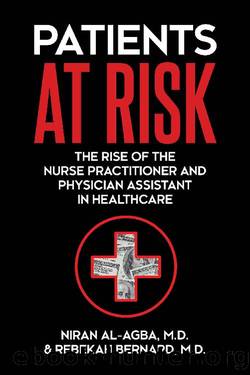Patients at Risk: The Rise of the Nurse Practitioner and Physician Assistant in Healthcare by Niran Al-Agba & Rebekah Bernard

Author:Niran Al-Agba & Rebekah Bernard [Al-Agba, Niran & Bernard, Rebekah]
Language: eng
Format: epub
Publisher: Universal-Publishers
Published: 2020-11-16T05:00:00+00:00
The Burlington Randomized Trial
Remember Drs. Sackett and Spitzer, the physician-scientists who started the first epidemiology department at McMasters University? In 1972, these forefathers of evidence-based medicine published one of the most important randomized controlled studies comparing physicians and nurses in practice.
Drs. Ian Hay and Pat Sweeney were two overwhelmed family physicians in a large urban medical practice in Ontario, Canada. Due to a shortage of primary care physicians, in 1970, half of the physicians in the province of Ontario were too busy to accept new patients. However, highly experienced and well-educated nurses were abundant. Hay and Sweeney employed two such nurses, Georgi Lefroy and Isabel Vandervlist. The physicians thought so highly of their nurses that they wondered if the two could assume some of the primary care responsibilities traditionally carried out by physicians. Hay and Sweeney approached Sackett and Spitzer about studying whether or not nurses could be safely âsubstitutedâ for primary care physicians to alleviate their workload. This important research, known as the Burlington Randomized Trial, would forever change the future of the medical profession.367
In 1971, Sackett and Spitzer designed the first randomized controlled study ever conducted at McMaster University and the fourth ever done in history. The question they asked was this: Could the capacity to deliver primary care be increased by having nurse practitioners work in collaboration with family practice physicians? The answer was a resounding yes.
Working together as a team, the four highly motivated cliniciansâtwo physicians and two nurse practitionersâprovided exceptionally high-quality personalized medical care to their patients. Recognition of their care became legendary throughout the province. The collaboration was so successful and efficient that the practiceâs capacity to take on new families increased by 22%.
However, the study also showed very clearly that physician supervision was required to make such a model successful. Lefroy and Vandervlist were experienced nurses who received an additional year of advanced nurse training at McMasters School of Nursing to become nurse practitioners. Despite this experience, the nurses still needed input and assistance from their supervising physician about 33% of the time. The results also demonstrated that the nurse practitioners, under careful physician supervision, were as safe and effective as a physician 55â67% of the time.
This overall positive finding that nurse practitioners are âas goodâ as physicians 55â67% of the time has been quoted in literature reviews more than one hundred times. Usually, the results are cited this way: Nurse practitioners working in primary care have outcomes equivalent to those of physicians. But the citations rarely include the fact that the nurse practitioners in these studies were practicing under physician supervision, and they never point out an opposite way of looking at the findings, namely, that even under supervision, nurse practitioners were not as good as physicians up to 45% of the time. Patients are not receiving an accurate message. They are not being told that nurses are as safe and effective as a physician most of the time, while under physician supervision. Instead, they are being led to believe that unsupervised nurse practitioners are every bit as good as physiciansâand maybe even better.
Download
This site does not store any files on its server. We only index and link to content provided by other sites. Please contact the content providers to delete copyright contents if any and email us, we'll remove relevant links or contents immediately.
| Administration & Medicine Economics | Allied Health Professions |
| Basic Sciences | Dentistry |
| History | Medical Informatics |
| Medicine | Nursing |
| Pharmacology | Psychology |
| Research | Veterinary Medicine |
Periodization Training for Sports by Tudor Bompa(7928)
Why We Sleep: Unlocking the Power of Sleep and Dreams by Matthew Walker(6362)
Paper Towns by Green John(4804)
The Immortal Life of Henrietta Lacks by Rebecca Skloot(4261)
The Sports Rules Book by Human Kinetics(4079)
Dynamic Alignment Through Imagery by Eric Franklin(3923)
ACSM's Complete Guide to Fitness & Health by ACSM(3826)
Kaplan MCAT Organic Chemistry Review: Created for MCAT 2015 (Kaplan Test Prep) by Kaplan(3803)
Introduction to Kinesiology by Shirl J. Hoffman(3627)
Livewired by David Eagleman(3535)
The River of Consciousness by Oliver Sacks(3420)
The Death of the Heart by Elizabeth Bowen(3342)
Alchemy and Alchemists by C. J. S. Thompson(3298)
Descartes' Error by Antonio Damasio(3167)
Bad Pharma by Ben Goldacre(3100)
The Emperor of All Maladies: A Biography of Cancer by Siddhartha Mukherjee(2932)
The Gene: An Intimate History by Siddhartha Mukherjee(2928)
The Fate of Rome: Climate, Disease, and the End of an Empire (The Princeton History of the Ancient World) by Kyle Harper(2876)
Kaplan MCAT Behavioral Sciences Review: Created for MCAT 2015 (Kaplan Test Prep) by Kaplan(2817)
